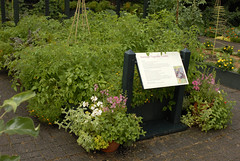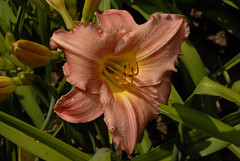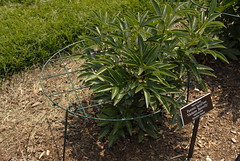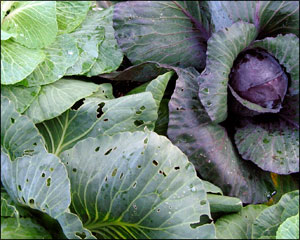Inside The New York Botanical Garden
Gardening Tips
Posted in Gardening Tips on July 21 2008, by Sonia Uyterhoeven
Heavenly Herbs
 Sonia Uyterhoeven is Gardener for Public Education at The New York Botanical Garden.
Sonia Uyterhoeven is Gardener for Public Education at The New York Botanical Garden.
 Herbs are easy to grow and are rewarding for the culinary-minded gardener. It is better to neglect your herbs rather than take too much care or to fuss over them. The most work you will need to do is pinching back herbs so that they don’t get leggy or go to flower.
Herbs are easy to grow and are rewarding for the culinary-minded gardener. It is better to neglect your herbs rather than take too much care or to fuss over them. The most work you will need to do is pinching back herbs so that they don’t get leggy or go to flower.
- Most herbs like full sun; the few exceptions that can handle part shade are parsley, mint, dill, and basil.
- Herbs like good drainage—if they are container-grown, normal potting soil will do.
- Herbs tend to be more fragrant when not fertilized and kept lean—basil is the exception.
- Basil, dill, and cilantro are easy to sow from seeds. Basil is not frost hardy and needs to be placed outside after the last frost date; cilantro on the other hand is a fast-growing, cool-season crop.
- Mints have a tendency to be invasive and are best used as either container plants or planted in a large pot that is sunk into the ground. This will provide an effective barrier for about 3 years.
Experiment with herbs in your garden and have fun. This year we have ‘Doone Valley’ thyme and silver thyme (Thymus vulgaris ‘Argenteus’) in the vegetable garden; they both have a wonderful citrus fragrance. Cuban oregano (Plectranthus amboinicus) is a newcomer to the vegetable garden this year with its pungent foliage. It can be used just like sage in cooking. Basil ‘Red Rubin’ retains its red color even as it ages and is a staple in the Home Gardening Center, but there are so many others to choose from such as the exotic Thai basil ‘Siam Queen’.
Posted in Gardening Tips on July 14 2008, by Sonia Uyterhoeven
A Fragrant Daylily
 Sonia Uyterhoeven is Gardener for Public Education at The New York Botanical Garden.
Sonia Uyterhoeven is Gardener for Public Education at The New York Botanical Garden.
 Daylilies are marvelous additions to the summer border. They are easy to grow and have large, trumpet-shaped blooms that scream out “Look at me!” Hybridizing daylilies is a passion of many, and the market is always flooded with a multitude of options. Some are short, some are tall, some have flowers the size of your hand. The latest trends are for re-blooming daylilies that flower from July into September. Rosy Returns is a popular performer, Apricot Sparkles is a peachy compact choice, the dark-eyed Moonlight Masquerade will woe you with the striking contrast of wine and cream, and Indian Giver will quickly find a way into your heart with its iridescent rose-pink flowers.
Daylilies are marvelous additions to the summer border. They are easy to grow and have large, trumpet-shaped blooms that scream out “Look at me!” Hybridizing daylilies is a passion of many, and the market is always flooded with a multitude of options. Some are short, some are tall, some have flowers the size of your hand. The latest trends are for re-blooming daylilies that flower from July into September. Rosy Returns is a popular performer, Apricot Sparkles is a peachy compact choice, the dark-eyed Moonlight Masquerade will woe you with the striking contrast of wine and cream, and Indian Giver will quickly find a way into your heart with its iridescent rose-pink flowers.
While longevity of bloom is always appealing, don’t overlook the fact that a number of daylilies have fragrance. My favorite is a pale lemon-yellow daylily named Hyperion. It has a happy home in the corner of my vegetable garden and is the main attraction in July. Often plants are described as being fragrant when they have a light scent—this one is truly fragrant. Other fragrant daylilies include Kathy Rood, Fragrant Light, Scape Stopper, and Vanilla Fluff.
Posted in Gardening Tips on July 8 2008, by Sonia Uyterhoeven
What’s at Stake?
 Sonia Uyterhoeven is Gardener for Public Education at The New York Botanical Garden.
Sonia Uyterhoeven is Gardener for Public Education at The New York Botanical Garden.

The best advice that I have ever heard about staking plants in the garden is twofold: Stake early before the plants need it, and don’t put your plants in a straight jacket—the idea is to see the plant and not the staking.
The aim then is to hide the stakes in the plant; when using string or twine pass it underneath the foliage and work with the natural structure of the plant. There are many different staking techniques and products available to the gardener.
You can use store-bought products such as peony hoops that fit neatly over the plant and can be raised up as the perennial grows. A plethora of stakes are available in gardening centers and from catalog companies; find the ones that work for you and your perennials.
For some jobs you can take the bounty of your spring pruning and use the branches as stakes. I have done this in the vegetable garden in the Home Gardening Center using leftover butterfly bush (Buddleia) branches to hold up peas and climbing nasturtiums. The key here is to place the twigs close to each other and get them deep enough into the ground so that they can support the plant.
Most of the staking done in this garden is done the old-fashioned way, with bamboo stakes and string. The stake generally needs to support only the bottom half of the perennial; in this way it doesn’t obstruct the view of the flower spike and lets the plant move naturally in the wind.
If the plant can only be viewed from one direction, stake from behind. If the plant can be viewed from all four sides, place the cane in the center of the plant. Drive the cane deeply into the ground to give maximum support. When tying the stems, work the strings beneath the foliage. Make a figure eight around the stem with the string and tie to the stake. If the plant has multiple stems, loop the string around all the main stems and tie to the stake.
Posted in Gardening Tips on July 1 2008, by Sonia Uyterhoeven
Slugging It Out
 Sonia Uyterhoeven is Gardener for Public Education at The New York Botanical Garden.
Sonia Uyterhoeven is Gardener for Public Education at The New York Botanical Garden.
I love hostas. Since they are so overused they have the potential for being an exceptionally boring plant, yet they are saved by the fact that they excel in shade, are wonderful foliage plants, and come in so many different shades, textures, and sizes.
The only problem is that by midsummer they are full of holes. Hostas are a staple of the slug’s diet, so often a little extra care from the gardener is needed to keep them from an “unholy” state.
Commercial products that prevent slugs from devouring hostas contain iron phosphate and are safe and easy to use. There are also many home remedies. The classic one is to set out a bowl of beer, leading to the slugs drowning to their delight. Rumor has it that slugs will travel up to two miles for a good drink.
Another simple alternative is to surround your hostas with a small barrier of used coffee grounds: caffeine kills slugs. You can also surround your hostas with diatomaceous earth or trap them with grapefruit rinds (you are then left to clean up the mess). Hostas that have thick, puckered leaves are less susceptible to attack.
Posted in Gardening Tips on June 24 2008, by Sonia Uyterhoeven
Rose Companions
 Sonia Uyterhoeven is Gardener for Public Education at The New York Botanical Garden.
Sonia Uyterhoeven is Gardener for Public Education at The New York Botanical Garden.
 Everyone needs a good friend, and roses are no exception. As the growing season progresses, the tops of roses remain nice and lush, but the bottom can start to look leggy and sparse. Hiding their bare legs with a companion plant is a simple remedy.
Everyone needs a good friend, and roses are no exception. As the growing season progresses, the tops of roses remain nice and lush, but the bottom can start to look leggy and sparse. Hiding their bare legs with a companion plant is a simple remedy.
The wispy flowers and foliage of ornamental sage (Salvia), Russian sage (Perovskia), and catmint (Nepeta) are three good options. Annuals to think about are cherry pie (Heliotrope), Lantana (Lantana), or summer snapdragons (Angelonia).
Aside from aesthetic qualities, some companions are said to protect other plants or enhance their growth. Members of the onion family are rumored to ward off aphids and help prevent black spots, so plant your alliums around your roses. Scented geraniums (Pelargonium), rue (Ruta), and feverfew (Tanacetum) are reported to repel Japanese beetles.
Remember that companions not only need to look good together, but also require compatible growing conditions. Roses perform best in full sun and in soil with good drainage; their companions should do the same.
Posted in Gardening Tips, NYBG in the News on June 18 2008, by Plant Talk
The gorgeous June weather has drenched the Peggy Rockefeller Rose Garden with plenty of sunshine, and the roses have responded. With roses on everyone’s mind, The New York Botanical Garden’s own Peter Kukielski, Curator of the Peggy Rockefeller Rose Garden, provided pruning tips for the folks at Fine Gardening Online

View Peter’s valuable tips for pruning:
Shrub Roses
Floribunda Roses
Hybrid Tea Roses
Posted in Gardening Tips on June 10 2008, by Sonia Uyterhoeven
Cutting Back on Work
 Sonia Uyterhoeven is Gardener for Public Education at The New York Botanical Garden.
Sonia Uyterhoeven is Gardener for Public Education at The New York Botanical Garden.

Have you ever noticed how some plants look just great in the fall? They are nice, neat and full. Generally, that is not the natural growth habit. A little care has to be taken earlier in the season to ensure their fullness, and now is the time.
You can pinch your mums starting in mid to late May to give them a nice full shape. An easier option is to wait until mid-June and just sheer them back by about half. I take a good pair of hedge sheers and cut them so they look like nice, rounded domes. They will keep the shape as they grow throughout the summer.
If you don’t have sheers, just take your bypass pruners to make your cuts. Remember, gardening is not an exact science, so just shape them so they look nice. What you are doing with the cuts (heading cuts) is encouraging lateral shoots (side shoots) to branch out and create a more compact, full shape.
With our tall Korean mums, which are the envy of every visitor in late October through early September, we cut them back twice. The initial cut is in mid-June and the second cut happens three weeks later, around July 4. The holiday is a helpful reminder of the cut-off date. If you continue sheering these late season bloomers throughout the summer, they will flower too late in the season and get knocked back by the frost.
Asters also get cut back in this fashion. Often we further support our asters by placing a peony hoop over them early in the season. These hoops are raised as the plant grows to give added support.
You don’t have to limit yourself to these two classics. Beebalm (Monarda) responds well to this treatment, as does Joe Pye weed (Eupatorium), Helen’s flower (Helenium), and a whole host of perennials.
Posted in Gardening Tips on June 3 2008, by Sonia Uyterhoeven
Weed-Free Heaven
 Sonia Uyterhoeven is Gardener for Public Education at The New York Botanical Garden.
Sonia Uyterhoeven is Gardener for Public Education at The New York Botanical Garden.
 Gardening is much like housekeeping—as long as you keep on top of things nothing will get the best of you. Following a few simple rules and some good horticultural practices will ensure that you don’t end up being swamped with one big green mess.
Gardening is much like housekeeping—as long as you keep on top of things nothing will get the best of you. Following a few simple rules and some good horticultural practices will ensure that you don’t end up being swamped with one big green mess.
Here are a few tips to keep weeds at bay:
Keep your garden a reasonable size, stagger your spring planting (remember freshly cultivated soil is an invitation for weeds), choose low maintenance plants, weed often (spend ½ hour a few times a week to keep your garden weed-free), attack flowering weeds first (don’t let them go to seed), hoe when the ground is dry, and hand pull when the ground is wet.
Posted in Gardening Tips on May 27 2008, by Sonia Uyterhoeven
Annual Affairs
 Sonia Uyterhoeven is Gardener for Public Education at The New York Botanical Garden.
Sonia Uyterhoeven is Gardener for Public Education at The New York Botanical Garden.
 For nonstop color in the garden, you really can’t beat annuals. For those of you who are not blessed with bright sunshine, last year we featured quite a few begonias in the Garden and I have a deepening respect for the plants.
For nonstop color in the garden, you really can’t beat annuals. For those of you who are not blessed with bright sunshine, last year we featured quite a few begonias in the Garden and I have a deepening respect for the plants.
We planted a number of Rex Begonias as an ornamental ground cover. During the latter half of the summer I would make flashy floral centerpieces by combining the begonia’s bright foliage with the silver-pink swirls of roses and hydrangeas. When I lived in Massachusetts, I used to keep my dappled borders bright with the nonstop begonias (tuberous begonias). The apricot and pinks were so beautiful that I would add them to shady containers to complement my coleus and fuchsias.
Read More
Posted in Gardening Tips on May 20 2008, by Sonia Uyterhoeven
Cabbage Worms
 Sonia Uyterhoeven is Gardener for Public Education at The New York Botanical Garden.
Sonia Uyterhoeven is Gardener for Public Education at The New York Botanical Garden.
 Cabbages make an excellent early season crop. Plant them in early to mid April and you will have a nice harvest by mid-June. Sometime in May you may see a pretty little white butterfly hovering around your cabbages, and shortly thereafter you will notice some holes appearing in your leaves until the beautiful, glaucous foliage looks more like Swiss cheese. You have cabbage worms. The easiest way to control this problem is to send your kids out and have them handpick the small green caterpillars (the culprits for all the holes).
Cabbages make an excellent early season crop. Plant them in early to mid April and you will have a nice harvest by mid-June. Sometime in May you may see a pretty little white butterfly hovering around your cabbages, and shortly thereafter you will notice some holes appearing in your leaves until the beautiful, glaucous foliage looks more like Swiss cheese. You have cabbage worms. The easiest way to control this problem is to send your kids out and have them handpick the small green caterpillars (the culprits for all the holes).
Read More
 Sonia Uyterhoeven is Gardener for Public Education at The New York Botanical Garden.
Sonia Uyterhoeven is Gardener for Public Education at The New York Botanical Garden. Herbs are easy to grow and are rewarding for the culinary-minded gardener. It is better to neglect your herbs rather than take too much care or to fuss over them. The most work you will need to do is pinching back herbs so that they don’t get leggy or go to flower.
Herbs are easy to grow and are rewarding for the culinary-minded gardener. It is better to neglect your herbs rather than take too much care or to fuss over them. The most work you will need to do is pinching back herbs so that they don’t get leggy or go to flower.








 Cabbages make an excellent early season crop. Plant them in early to mid April and you will have a nice harvest by mid-June. Sometime in May you may see a pretty little white butterfly hovering around your cabbages, and shortly thereafter you will notice some holes appearing in your leaves until the beautiful, glaucous foliage looks more like Swiss cheese. You have cabbage worms. The easiest way to control this problem is to send your kids out and have them handpick the small green caterpillars (the culprits for all the holes).
Cabbages make an excellent early season crop. Plant them in early to mid April and you will have a nice harvest by mid-June. Sometime in May you may see a pretty little white butterfly hovering around your cabbages, and shortly thereafter you will notice some holes appearing in your leaves until the beautiful, glaucous foliage looks more like Swiss cheese. You have cabbage worms. The easiest way to control this problem is to send your kids out and have them handpick the small green caterpillars (the culprits for all the holes).